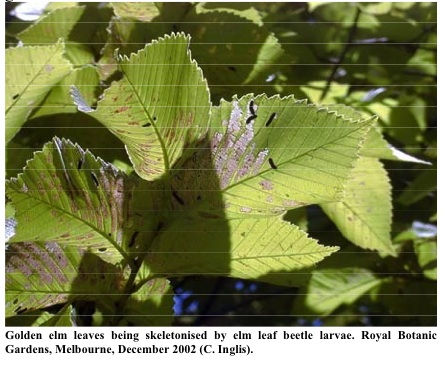PESTS AND DISEASES OF FORESTRY IN NEW ZEALAND
Victoria's see-through elms
Scion is the leading provider of forest-related knowledge in New Zealand
Formerly known as the Forest Research Institute, Scion has been a leader in research relating to forest health for over 50 years. The Rotorua-based Crown Research Institute continues to provide science that will protect all forests from damage caused by insect pests, pathogens and weeds. The information presented below arises from these research activities.
From Forest Health News 127, March 2003.
Victoria has the greatest number of elms in Australia. In Melbourne these trees form the main structural plantings in streets and parks. Their summer shade is welcome when temperatures soar above 34 degrees and hot winds carry red desert dusts. Large golden elms (Ulmus glabra ‘lutescens’) are a landscape feature of private gardens north to the Yarra Valley. However, the most numerous species, which is commonly called English elm (U. procera *), was planted as early as 1850 in long avenues according to the English school of landscaping.
 It is not hard to see why Victorians are concerned about Dutch elm disease and have contingency plans at the ready in case it arrives. Their elms generally appear remarkably healthy, with no sign of the crown dieback so commonly seen in green-crowned elms in Auckland. This situation has unfortunately been threatened with the discovery of the European elm leaf beetle (Pyrrhalta luteola ) close to Melbourne in 1989. The major damage from this pest is caused by the prominent slug-like larvae, which severely skeletonise the foliage. Some measure of control is achieved by treatment with insecticides such as carbaryl, and by applying a band of sticky gel to the tree trunk to trap larvae as they move down the tree trunk to pupate1. A derivative of Bacillus thuringiensis (Bt) is also effective. Nevertheless, this insect is a pernicious pest, which threatens to “exhaust” the elms as new leaves are continually rendered “see-through” and ineffective for growth.
It is not hard to see why Victorians are concerned about Dutch elm disease and have contingency plans at the ready in case it arrives. Their elms generally appear remarkably healthy, with no sign of the crown dieback so commonly seen in green-crowned elms in Auckland. This situation has unfortunately been threatened with the discovery of the European elm leaf beetle (Pyrrhalta luteola ) close to Melbourne in 1989. The major damage from this pest is caused by the prominent slug-like larvae, which severely skeletonise the foliage. Some measure of control is achieved by treatment with insecticides such as carbaryl, and by applying a band of sticky gel to the tree trunk to trap larvae as they move down the tree trunk to pupate1. A derivative of Bacillus thuringiensis (Bt) is also effective. Nevertheless, this insect is a pernicious pest, which threatens to “exhaust” the elms as new leaves are continually rendered “see-through” and ineffective for growth.
Should this pest reach New Zealand, early detection is likely. Auckland has a very active Dutch elm disease eradication programme, with all known elms being inspected three times each summer (FHNews125: 1). It is probable that any elm leaf beetle larvae would be quickly spotted and rapidly dealt with.
Chris Inglis, Vigil
* Spencer, R.; Hawker, J.; Lumley. P. (1991): Elms in Australia, Royal Botanic Gardens, Melbourne. These authors draw attention to the complexities encountered in determining the true identities of some of Victoria’s elms.
This information is intended for general interest only. It is not intended to be a substitute for specific specialist advice on any matter and should not be relied on for that purpose. Scion will not be liable for any direct, indirect, incidental, special, consequential or exemplary damages, loss of profits, or any other intangible losses that result from using the information provided on this site.
(Scion is the trading name of the New Zealand Forest Research Institute Limited.)



